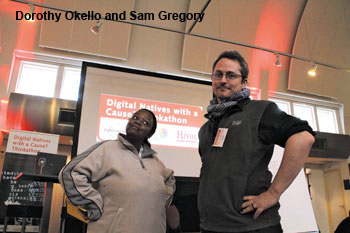I make a rushed visit to The Hague, where Nishant Shah and Sunil Abraham (who together run the Centre for Internet and Society in Bengaluru, and are in my mind, two of the smartest people living in India right now) have collaborated with the Dutch organisation Hivos to put together a thinkathon on ‘Digital Natives with a Cause?’ This is the third event in a series on technology, youth and engagement, that began in Taipei, moved on to Johannesburg, and will finally end in Santiago, Chile this coming February.
Nishant and Hivos’ fabulous Fieke Jansen set the tone by talking about why the question mark at the end of the title ‘Digital Natives for a Cause?’ is important. Can one think of digital natives as simply youth who have grown up with technology or can we include other older people within this term? What does it mean talking about digital natives and questions of transformation and change? What does it mean to even have a cause? Does a cause have to be framed in certain language? I discuss and debate all of this and much more with an incredible group of change-making activists, policy makers and artists from all over the world.
These include folks like Prabhas Pokherel from UNICEF Kosovo, Eddie Avila from Rising Voices Bolivia, Dorothy Okello from the Women of Uganda Network, and Simeon Oriko from the Kuyu Project in Kenya. I’m fascinated by all that they are doing. Kuyu, for instance, aims to teach young African students how to use various forms of social media to make a positive impact in their communities, through online Wikis, mobile phone networks and digital training camps. Nonkululekho Godana’s uniquely South African fashion sense catches my eye and we discuss shopping during the fun dinners, each of which is at a spectacular location in The Hague. Our thinkathon venue is the Museum of Communication, which itself is very special, with its talking installations and special multimedia galleries.
Being here gives me a chance to meet Sam Gregory from Witness, Peter Gabriel’s organisation and website that trains and equips individuals across the world to use video to document human right violations and effect change. I’ve been a big fan of what they’re doing ever since they started. It’s also great to hang out with Ushahidi’s Juliana Rotich, even if it’s only for a little while. Ushahidi develops free open source software for information collection, visualisation and interactive mapping that anyone can use to further their cause. For example, Vote Report India – that catalogued the 2009 general elections – was built on this platform.
I am extremely happy with the quality time I share with co-TED fellow Jasmeen Patheja. I’m sure that you’ve heard of her Blank Noise Project; it is a physical and virtual artistic intervention that aims at creating public awareness about eve teasing. Jasmeen has just returned from Tokyo where she’s been cataloguing Japanese women’s stories about harassment. Together, we roll our eyes at how similar men all over the world are!
At the thinkathon, a hot topic of discussion is slactivism or slacker activism that a lot of social media seems to be promoting. Is signing an online petition the same as protesting on the ground, in real life? How might we conceptualise a button clicker as an agent for social transformation? Beyond this, how might we engage digital natives in terms of policy-making processes?
* This post is a modified version of my column Parmesh’s Viewfinder which appears in Verve magazine every month.

